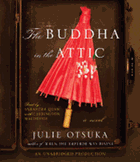
Beginning with the statement, "On the boat we were mostly virgins," Julie Otsuka's The Buddha in the Attic imagines the voices of Japanese "picture brides" who emigrated to California in the early 1900s. The young women and girls (some only 14 years old) disembark to fiancés who might not resemble their photos and to non-wifely duties as cooks, housemaids, field hands and prostitutes. In the place of dramatic scenes, Otsuka uses an imagistic storytelling technique of spare, poetic details that describe the disposition of people and objects (viz the book's title). A thematic predecessor to Otsuka's earlier novel,When the Emperor Was Divine, that National Book Award finalist is also striking for its use of a multiple and continuous "we" narrative voice to blend dozens of lives into a chorus of experience.
The Buddha in the Attic's multiple narrative voice works well in audiobook form, and its short, episodic chapters can be stopped and started without losing the thread. Greek tragedy and the musical comedy have trained us to absorb the oral recitation of plural fates, and hearing it read aloud helps personify the collective and historical context of The Buddha in the Attic. Otsuka uses the first-person-plural to confide more directly to readers. Her repetitive use of the phrase "some of us" and her Hemingwayesque abrupt sentences fall easier on the ear than on the eye. Actress Samantha Quan's soft but assertive voice lends a poetic rhythm to the novel's sequential observations. Another boon of the audiobook is that the eighth chapter's harsh shift of perspective is accentuated by the switch to a less poetic voice. --Holloway McCandless, blogger at Litagogo: A Guide to Free Literary Podcasts

